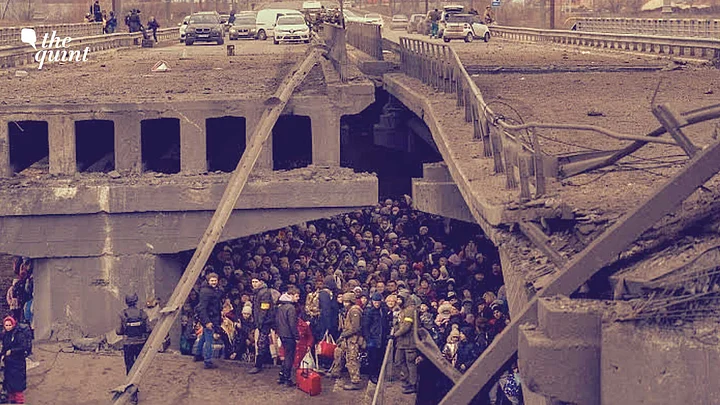As the Russian invasion of Ukraine enters day 13 on Tuesday, 8 March, the term "humanitarian corridors" has come up quite a few times within the past week.
Most recently, the Russian Embassy in India announced on 8 March that it was ready to set up humanitarian corridors in order to conduct evacuation.
The announcement came one day after Ukraine rejected Russia's proposal for a humanitarian corridor, to evacuate civilians via routes that led to Russia and Belarus.
So, what are humanitarian corridors? And which ones have been set up to evacuate civilians from Ukraine?
What are Humanitarian Corridors?
Humanitarian corridors, in a conflict zone, are temporary demilitarised zones, when a city or district is under attack.
The demilitarisation is agreed upon by the belligerents in order to allow the civilian population to escape, eliminating the risk of getting killed in crossfire.
Designated routes are drawn for civilians to use for fleeing. These routes are also often used to transfer urgent humanitarian aid for civilians who, for whatever reason, are unable to leave the conflict zone.
Aid in this context can range from medical aid to food, water, and other essential supplies.
The present understanding of humanitarian corridors dates back to the Bosnian War (1993), when 'United Nations Safe Areas' were established and designated as protected areas.
Usually, such corridors are negotiated and established by the United Nations. Local NGOs often take part in this process too, if all sides have agreed to it.
Naturally, humanitarian corridors can only be enforced when there is a ceasefire, and if the ceasefire is followed by both sides.
Humanitarian Corridors in the 2022 Ukraine War
A humanitarian corridor was established on 8 March to evacuate the hundreds of international students (a lot of Indians among them) from Sumy.
Russia provided "two routes to Poltava and to the territory of the Russian Federation to Belgorod – then by air, rail and road transport to selected destinations or temporary accommodation, in the southern direction – in agreement with the Ukrainian side."
A summary of the other humanitarian corridors offered by Russia is as follows:
From Kyiv and adjacent settlements to Russia through Belarus (via a city called Gomel)
From Chernigov through Belarus (via Gomel) to Russia
From Kharkiv to Belgorod (in Russia) and then to selected destinations like Lviv or Uzhgorod
From Mariupol to Rostov-on-Don(in Russia) through Novoazovsk and Taganrog cities, then to Zaporozhye.
It is yet to be seen whether Ukraine will accept the above mentioned routes proposed by Russia.
Ukraine's Problem With the Corridors
In eastern Ukraine, on 5 March, a five-hour cease-fire was initially agreed upon to allow up to 2,00,000 people to evacuate from Mariupol and around 15,000 from Volnovakha.
But the corridor collapsed in a matter of hours, with the Mariupol city administration claiming that the evacuation had to be "postponed for security reasons" because Russian troops had not ceased their attacks.
Russia, on the other hand, blamed Ukrainian "nationalists", and accused them of preventing civilians from escaping.
Then, on 7 March, Moscow stated that humanitarian corridors would be set up to evacuate civilians from Kharkiv, Mariupol, and Kyiv, so that they can flee via corridors to Russia and Belarus.
Kyiv categorically rejected these corridors, and called the plan an "immoral" stunt by Russia.
A spokesperson for Ukrainian government told Reuters that "they are citizens of Ukraine, they should have the right to evacuate to the territory of Ukraine".
Even the French President Emmanuel Macron, accused Vladimir Putin of "moral and political cynicism", with respect to the latter's promise of protecting civilians only if they flee to Russia.
"I do not know many Ukrainians who want to go to Russia," Macron said, as quoted by The Guardian.
What About Non-Ukrainians?
The problem is that while Ukrainians probably don't want to go to Russia in order to flee the war, the same might not be the case for non-Ukrainians.
For instance, the Indian students stranded in Sumy are about 60 km away from the Russian border (Belgorod).
They don't have much of a choice to go anywhere other than Belgorod, unlike others in western Ukraine who can make their way to Poland, Slovakia, and Romania.
They even told the The Quint that the Indian embassy had informed them about 130 buses that would be operating to take them to Belgorod.
"But we are not getting permission from the Ukrainian government to go there", they had said, as curfew had been imposed due to heavy Russian shelling.
Ultimately, Union Minister Hardeep Singh Puri confirmed on 8 March that 694 Indian students have left Sumy and are on their way to Poltava (in central Ukraine), therefore avoiding the Russian border option.
(With inputs from The Guardian and Reuters.)
